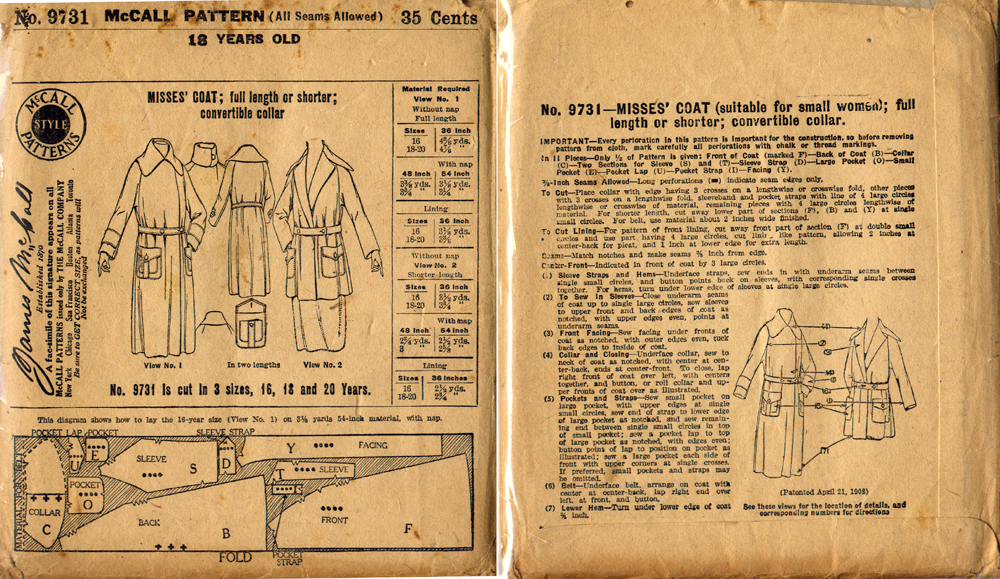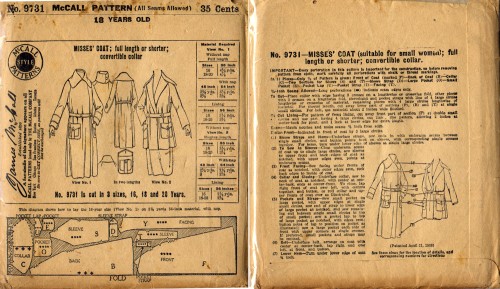When you find a date on a vintage pattern envelope, surely it must be the date of the original design. Or so one would think! But dates on patterns aren’t always for design, or even the year they were published. How can we find out what the date actually means?
Let’s talk about now to navigate the world of patterns and patents. To be clear, we’re talking here about patents in the United States, since that’s where I live and what I know about.
What is a patent? And how is it different than a copyright?
A patent is a form of intellectual property that’s often related to inventions.
Let’s pretend you’ve invented a new sewing tool that attaches to a home sewing machine that can sew buttonholes and cut buttonholes all in one go, and that’s never been invented before. That invention could be protected by a patent to be sure that someone doesn’t come in, swoop up your idea, and claim it as their own invention. Usually, old patents included a technical drawing and a description. As long as the patent is in force your new invention or technology is protected, and you can follow legal action against anyone who tries to steal your thunder.
Mass produced tissue home sewing patterns were a relatively new invention, having come out of the Victorian era. Notice I say tissue and home sewing patterns there, as sewing patterns and cutting diagrams had been around for a long while, especially for professionals. The advent of machinery and printing for a home-based everyday consumer was a fierce battle in a time when most families sewed at least some of the items of clothing and household necessity.
For patterns, advents in technology and invention could have been a form of punching perforations for important markings, printing on pattern pieces, adding illustrated instructions, including cutting charts, the layout of a front or back cover, or any other type of thing that at one time was not the standard in the home sewing pattern market. The invention of your patent could protect any number of works made using that technology while the patent was still in force.
A copyright is a form of intellectual property that protects artwork, literature, music, or other types of creative works. A copyright is an accurate way to date a pattern because it is pattern specific. However, most sewing patterns did not include any copyrights until the 1950s, with a few exceptions. McCall added it after adopting printing on pattern pieces. And other companies could follow after also adapting that innovation, after the patent for printing on patterns had expired. Many companies did not convert to printed patterns until the 1950s.
(Side Note- I’m not giving copyright advice, legal advice, or answering questions as it is lengthy and complicated- we are just adding this distinction between the two for research purposes for this article.)
How long did a patent last?
According to Wikipedia:
For patents filed prior to June 8, 1995, the term of patent is either 20 years from the earliest filing date as above or 17 years from the issue date, whichever is longer.
Ok, so let’s look again at that pattern that’s patented 1908. Here’s one from my collection:

Now let’s see what suits looked like in magazines dated 1908:

Hmm… just a little bit different, right?
That’s because the pattern does NOT date to 1908. The pattern was PATENTED 1908. Using the information given above, the suit could be anywhere from 1908 to 1928!
Same with a pattern with a patent date of 1899, as some Butterick patterns have. The pattern could have been anywhere from 1899-1919.
What about those Butterick patterns patented 1919? They could be from 1919-1939.
Ok, so the dates are within 17-20 years. What do I do next to date this pattern?
Go to period sources and do a bit of sleuthing.
The next step is to see if you can find it in the original period source material that would be dated. For patterns, this is usually a magazine or catalog. Pattern companies were either owned by or worked in conjunction with magazines.
McCall’s used McCall’s magazine to advertise.
Butterick was in the Delineator.
Vogue was in Vogue Magazine.
Things get a little tricky with Ladies Home Journal magazines. They originally had Ladies Home Journal patterns, then they had Simplicity patterns, then they had Hollywood patterns, and then I’m afraid my interest wanes and I’m not sure what happened in the 1940s and later.
For an example, let’s demonstrate with pretending we’re looking up my pattern- McCall 9731. Since I know my history, the lines look late 1910s to early 1920s to me. I’m going to start around 1917, since that’s the very earliest I’d expect to see this design. I’ll plug in “McCall 1917 fashion” into Google images and see what pops up.

Looking at images, the fashion drawing will have a little four digit number next to it. That’s the pattern number. NineteenTeen has some images from 1917 McCall’s magazine on her blog and I see pattern numbers are in the 7000s. Nope, too early.
Let’s try 1918. Pattern Vault (an AMAZING blog that I drool over), has images from January 1918. Pattern numbers are late 7000s to early 8000s. Still too early! Since our number is 9731, this would have to start towards the end of 1918, at least.
Luckily, since this bog post was originally published, many antique McCall magazines have been put online for free (note- if you’re outside the USA it may be different). We can look at magazines individually and search for the number, or scroll through until we find the correct number sequence.
When I open up November1920, I found the correct pattern number sequence to place it correctly, as the pattern numbers featured are from 9670’s-9760’s. That places the pattern in late 1920, even though it has the 1908 patent date! This is because the patent was for the pattern technology adopted in 1908, not the garment design.
The ultimate pattern nerd moment, is, of course, finding the original pattern being mentioned, illustrated, and described in a magazine or catalog. Bliss!
I want to geek out even more!
Sweet! Me, too! And the free information online will help!
I love Butterick patterns because many Delinators are available for free online and you can often date the pattern by searching “delineator” plus the pattern number in the Google Books search.
As mentioned before, here’s the link for the McCall magazines available online to help you date early McCall patterns.
You can also search Google Patents for patents related to sewing pattern manufacturing. It’s fun to see the invention of things we take for granted today.
Here’s the patent for the McCall Printed Pattern. This explains why Simplicity started printing patterns in 1939 but not before.
Here’s the Butterick patent for cutting charts. We take these for granted now, but cutting charts were not standard! Butterick also innovated illustrated instructions with their introduction of the “Deltor” (rudimentary illustrated instructions), at a similar time when McCall patented the printed pattern. Very competitive innovation!
Hope this helps you date some of your pretties. And help you when you’re shopping for a specific time frame to chose the right thing!

Kate
November 11, 2018 at 4:16 pm (7 years ago)I don’t have much need for dating sewing patterns as I’m not a costumer, however my day job is to find information online on a big range of topics so I’m always interested to see the little tricks to find very specific types of information online. I didn’t know Google Books had Delineators on there, and I didn’t know there was a page for Google Patents, so thank you for adding two more tools to my online search arsenal!